Carp farming in the Philippines is a burgeoning industry, blending traditional methods with modern scientific approaches. Culturing carp for profit requires careful planning, from selecting the right species and location to implementing proper nutrition and disease management.
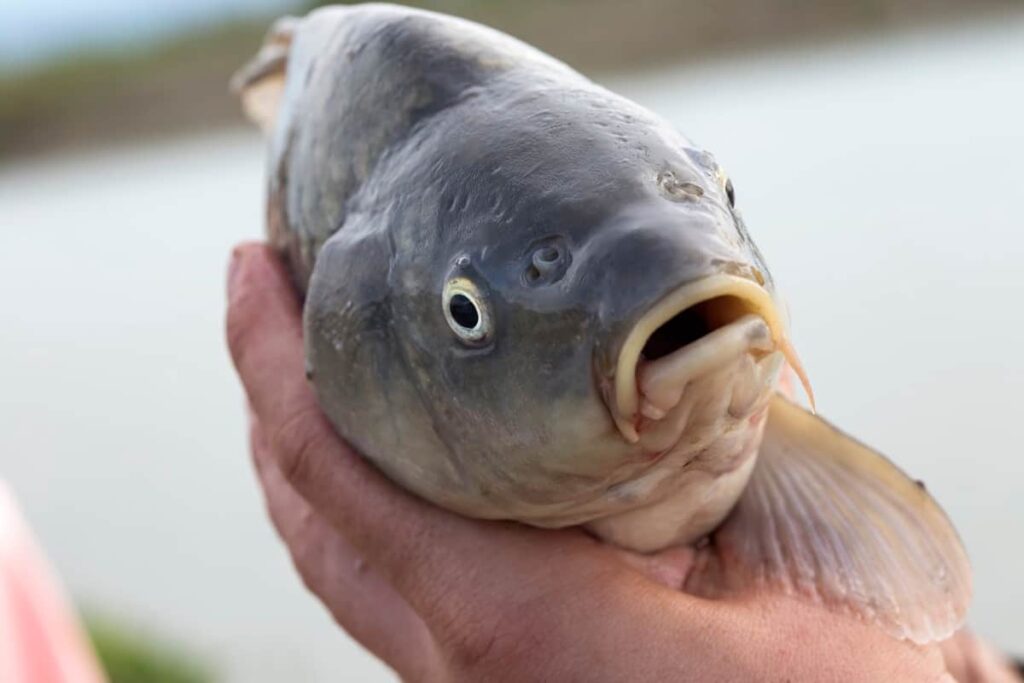
This blog will delve into the essential steps and considerations for profitable carp farming in the Philippines carp farming, offering novice and experienced farmers insights and guidance. Join us as we explore the intricacies of this lucrative venture, aiming to foster sustainability and profitability in the dynamic field of aquaculture.
What is Carp Farming?
Carp farming, scientifically known as aquaculture, involves the controlled cultivation of carp fish species in specialized environments such as ponds, tanks, or raceways. This practice is crucial for meeting the increasing global demand for fish protein. Carp, which belongs to the family Cyprinidae, are well-suited for farming due to their adaptability to various water conditions and relatively rapid growth rates.
CarefulCareful water quality, temperature, and feeding management are essential in carp farming to ensure optimal growth and health. The process begins with selecting healthy juvenile carp and providing them with appropriate nutrition.
Benefits of Carp Farming
The Simplicity of Farming: Carp farming offers a straightforward process that doesn’t demand intricate care or specialized attention. Their adaptability to diverse environments makes them suitable for novice and experienced farmers. This simplicity can lead to reduced operational complexities and increased chances of success.
Resilience in Challenging Conditions: Carp fish are renowned for their robustness. They can thrive even in conditions where water quality might not be ideal, exhibiting a tolerance for variations in water parameters. This hardiness minimizes the risks of sudden environmental changes, providing a buffer against unfavorable circumstances.
Rapid Growth: Carp demonstrate impressive growth rates, quickly attaining sizes suitable for commercial purposes. Their efficient conversion of feed into body mass makes them an attractive option for aquaculture. This characteristic allows farmers to achieve marketable sizes within a relatively short timeframe.
Versatile Diet: Carp are omnivorous, which means they consume a wide range of foods. This versatility in diet simplifies feeding practices. They can thrive on various types of feed, including aquatic plants, insects, and commercial feeds. This flexibility reduces dependency on specific feed sources and allows efficient resource utilization.
In case you missed it: Pangasius Farming in the Philippines: How to Culture Pangasius
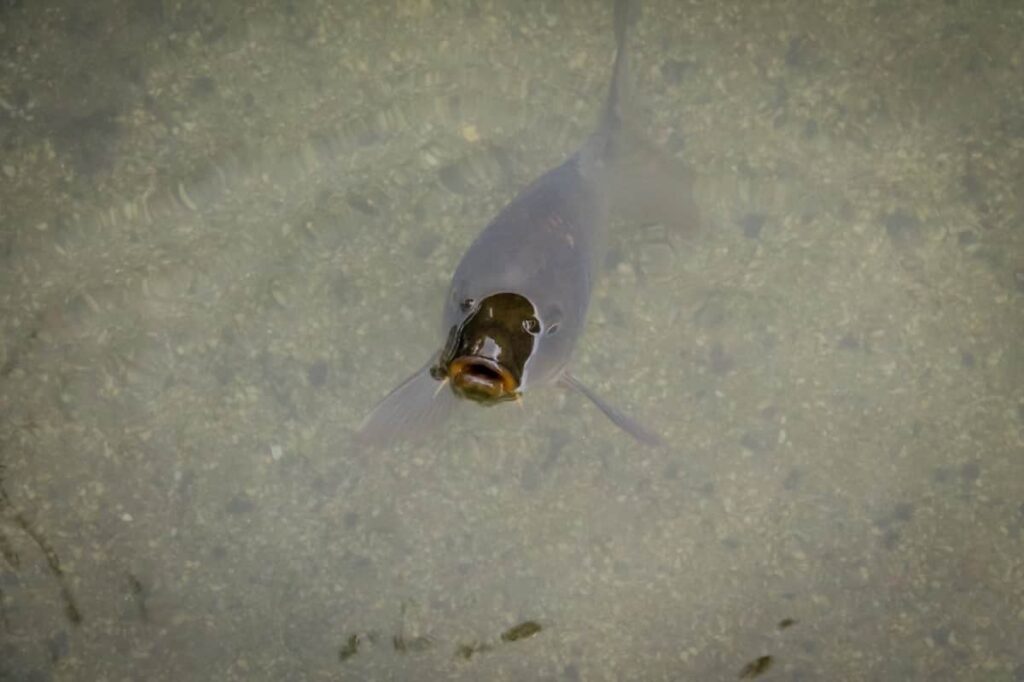
Disease Resistance: Carp naturally resist certain diseases that affect other fish species. This resistance is attributed to their hardiness and immune system. As a result, carp farming is associated with reduced susceptibility to common fish ailments, contributing to higher survival rates and less reliance on disease management interventions.
Multiple Utilization: Carp serve various purposes. They can be grown for food, both locally and for broader markets. Additionally, they are suitable for recreational fishing, contributing to the angling and tourism sectors. This multifaceted utility enhances the economic and recreational value of carp farming.
Carp Farming Techniques in the Philippines
Carp farming in the Philippines follows key techniques for successful cultivation. Local species like the common carp (Cyprinus carpio) and the silver carp (Hypophthalmichthys molitrix) are commonly raised. Farmers ensure water quality by maintaining proper oxygen levels, pH balance, and temperature control.
The Integrated Fish Farming approach combines fish with crops like rice and vegetables to optimize land and resource use. Polyculture, where different fish species coexist, helps maximize production and resource utilization. Farmers also focus on disease prevention through regular health checks, maintaining hygiene, and providing balanced nutrition. Community-based projects promote knowledge-sharing and sustainable practices among local fish farmers.
Types and Breeds of Carp in the Philippines
- Main Carp Types: Carps primarily come in common carp and mirror carp. Common carp are favored for farming due to their ease of care and higher yield. While more delicate, Mirror carp are prized in certain cultures for their unique appearance and can fetch premium prices.
- Variety of Breeds: Carp breeds differ in color, size, and shape. With its silver-gray hue, the Prussian carp is a prevalent breed of common carp. German mirror carp, Koi carp, and goldfish are popular breeds, each with distinct characteristics.
- Common Carp Variants: In the Philippines, common carp, including the Prussian variant, is well-suited for farming due to its adaptability. This species thrives in controlled environments and can also be found in certain rivers nationwide.
In case you missed it: Goldfish Farming in the Philippines: How to Farm Goldfish for Profit

Step-by-step Guide to Profitable Carp Farming in the Philippines
- Site Selection: Choose a calm water body with abundant vegetation, such as a pond or lake, as carp thrive in such environments.
- Pond Preparation: Ready the chosen pond by introducing vegetation, aerating the water, and maintaining optimal pH levels, all conducive to carp growth.
- Stocking Strategy: Introduce young carp (fingerlings) to the prepared pond, ensuring a suitable stocking rate to provide ample space and food for their healthy development.
- Feeding Regimen: Augment natural food sources with commercial carp feed. This accelerates growth and maintains fish health, guaranteeing a robust yield.
- Continuous Monitoring: Regularly monitor the pond’s condition, ensuring water quality remains high and fish growth progresses as anticipated. Adjust feeding and consider additional aeration if issues arise.
- Harvesting Process: Once the carp reach the desired size, commence the harvest. Employ proper techniques to minimize stress and optimize the quality of harvested fish.
Best Practices for Carp Farming in the Philippines
- Strategic Location: Opt for a location near a reliable water source, facilitating water supply for your carp. Select an area with favorable soil conditions to support optimal carp growth.
- Appropriate Carp Selection: Research and select the carp species that suit your farming area. Different types of carp have varying adaptability and growth rates.
- Optimal Pond Design: Construct a pond of suitable size that offers ample space for carp movement and growth. Implement an effective filtration system to maintain water cleanliness.
- Balanced Nutrition: Provide the right diet to your carp. While they consume diverse foods, they prioritize live sources like insects and small fish. Commercial pellets or flakes tailored for carp can also be utilized.
- Routine Maintenance: Regularly clean the pond to sustain water quality. Monitor both the pond environment and the fish’s health. Ensure the carp are thriving and growing as expected.
Carp Farming Equipment and Supplies in the Philippines
- Pond: The cornerstone of carp farming, the pond’s size depends on your intended fish population.
- Water Management: Employ a water pump and filtration system to maintain clean, fresh water in the pond, supporting carp health.
- Feed and Supplements: High-quality fish food is vital for carp growth and well-being. Supplements aid in reproduction and disease prevention.
- Netting: Protect your carp from predators using netting, and use it during harvest for efficient collection.
In case you missed it: Cavendish Banana Farming in the Philippines: Cultivation Practices
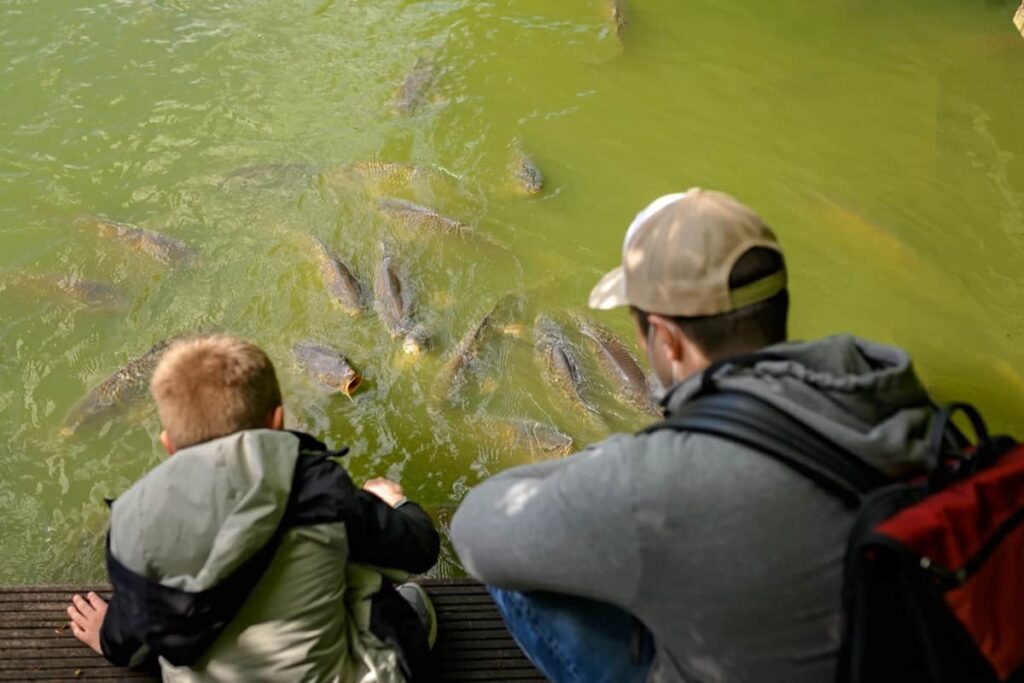
Feeding Strategies for Carp Farming in the Philippines
Feeding carp effectively in successful farming. Carp are omnivorous, consuming a range of foods. Supplemental feeding, like soybean meal, cereals, meat meal, or mixtures, is crucial. Rice bran and rice polishings can nourish fry. The nursery phase spans 3 to 4 weeks, resulting in 0.2-0.5 g final weight with a survival rate of 40-70%. Tank nursing using 5-100 m² tanks for predator-prone areas can be applied, nurturing fry up to 1-2 cm.
Creating zooplankton via hay and manure aids in feeding. Zooplankton, fine meals, or starter foods sustain them. Industrial systems like raceways or recirculating setups are also viable for nursing. A balanced diet promotes optimal development. Natural sources like aquatic plants and small organisms are beneficial.
Supplementing with high-quality commercial feeds ensures proper nutrition. Consider nutritional content, pellet size, and frequency of feeding. Monitoring fish behavior and appetite aids in adjusting feeding schedules. Overfeeding should be avoided, preventing water pollution and fish stress. Tailoring feeding to carp size and age optimizes results.
Water Quality Management in Carp Farming
Maintaining optimal water quality is important for successful carp farming. Monitoring key parameters like oxygen levels, pH, temperature, and ammonia concentration ensures a healthy aquatic environment. Adequate dissolved oxygen, typically 5-7 mg/L, supports fish respiration and growth. Maintaining pH within the 6.5-8.5 range prevents stress and enhances nutrient uptake.
Temperature influences carp metabolism; 25-30°C is generally ideal. Ammonia, a potential toxin, must be kept below 0.02 mg/L. Effective filtration systems, water exchange, and aeration aid in preserving water quality. Proper waste management prevents nutrient buildup and oxygen depletion. Carp’s health, growth, and survival hinge on pristine water conditions, making vigilant quality management a cornerstone of successful carp farming endeavors.
Disease Prevention and Control in Carp Farming
Bacterial infections, parasitic infestations, and viral outbreaks can impact fish populations. Maintaining good water quality, including proper filtration and aeration, reduces stress and disease susceptibility. Quarantine protocols for new fish arrivals prevent the introduction of pathogens. Regular health checks help detect issues early. Vaccination, though limited for carp, may be considered if available. Biosecurity measures like controlling visitors and equipment minimize disease transmission.
Effective nutrition strengthens immunity; a balanced diet rich in vitamins and minerals is crucial. Environmental management, including maintaining proper stocking density, prevents overcrowding stress. Prompt removal of sick or dead fish mitigates disease spread. Chemical treatments should be used judiciously, considering potential environmental impact.
In case you missed it: Pole Sitao Cultivation in the Philippines: Best Farming Practices
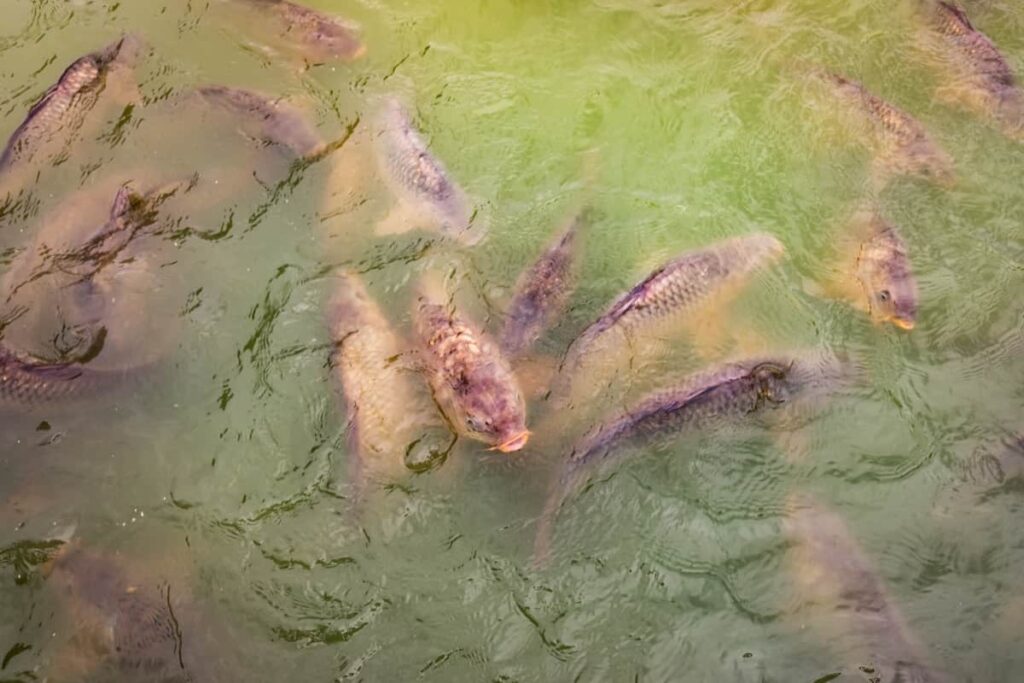
Market Opportunities for Carp Farming in the Philippines
Carp farming in the Philippines holds diverse market opportunities driven by fingerling production and growing techniques. Fingerling involves nurturing carp in semi-intensive ponds using natural food and supplementary feeds. Various approaches include single-stage, dual-stage, and multicycle systems.
Stocking nursed fry is effective for optimum results, yielding medium and large-sized fingerlings. Stocking densities vary with desired sizes, with survival rates achieved. Ongrowing techniques span two summer-old carp and market-sized fish production. Rearing one-summer-old fish to larger sizes in temperate zones is practiced, while market-sized fish production utilizes monocultural and polyculture systems.
Integration with animal husbandry and plant production enhances sustainability. Common carp can also be integrated into natural waters and reservoirs for enhanced capture fisheries. Natural food and supplementary feed-based approaches support fish growth. Harvesting employs undrainable or drainable ponds with nets. Partial harvesting boosts overall production. Handling, processing, and transportation depend on factors like size and condition.
Carp farming economics vary. In Hungary, profits reached EUR 326/ha. In India, the net profit from polyculture with common carp was USD 710/ha, while Bangladeshi small-scale farmers reported USD 510-1,580/ha profits from undrainable polyculture ponds. These market opportunities underscore the viability and potential of carp farming in the Philippines, encompassing various production techniques, integration strategies, and economic gains.
Carp Breeding and Reproduction Methods
Carp breeding involves strategic methods for successful reproduction. Induced breeding is widely used, and hormonal injections stimulate maturation and egg release. Males and females are isolated, then paired for spawning. Eggs and sperm are collected and fertilized in controlled environments. Incubation occurs in specialized tanks with controlled water parameters. Naturally, carp spawn during warmer months. Spawning happens in shallow waters with submerged vegetation. Eggs are adhesive, attaching to plants. After hatching, fry feed on their yolk sacs initially.
Carp Pond Construction and Maintenance
Carp pond construction and maintenance are vital for successful aquaculture. To build a pond, choose a suitable site with access to fresh water. Construct embankments with clay soil and a slight slope to prevent erosion. Adequate water supply and drainage systems are essential. Maintain a water depth of around 1.5 to 2 meters. Regularly inspect and repair embankments to prevent leaks.
Install aeration and filtration systems for water quality. Maintain optimal oxygen levels, pH, and temperature. Control vegetation growth to ensure sunlight penetration. Conduct routine maintenance, like removing sediment and debris, to prevent water stagnation. Proper pond management ensures a healthy environment for carp growth, supporting sustainable and productive farming practices.
Carp Growth Rates and Optimal Feeding Schedules
Carp exhibit varying growth rates depending on water temperature, food availability, and genetics. Typically, they can grow from a few grams to several kilograms yearly. Optimal feeding schedules depend on fish size and water temperature. Younger carp require frequent feeding, while larger fish need fewer meals. Providing appropriate commercial feeds or natural food sources supports healthy growth.
In case you missed it: Exploring the Potential of Hydroponic Farming in the Philippines
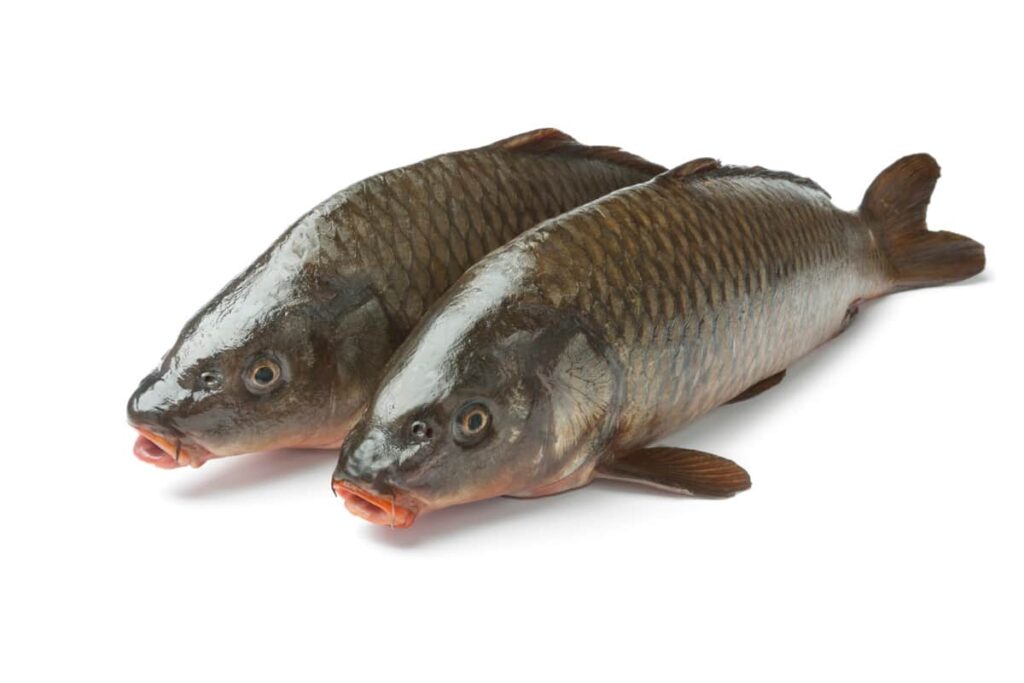
Conclusion
Carp farming in the Philippines offers a lucrative venture for sustainable protein production. Strategic approaches in breeding, feeding, and pond management, coupled with local adaptability, pave the way for profitable outcomes and contribute to food security and economic growth.
- How to Raise Pigs in Your Own Backyard: A Comprehensive Guide
- Budget Friendly Sheep Shed Ideas: Cheap and Low-Cost Tips
- How Much Do Cattle Farmers Make: Revenue Streams in Cattle Farming
- Management Pests and Diseases in Your Cotton Field
- Sheep Farming Business Plan for Beginners
- Aquaponic Farming at Home: A Step-By-Step Guide
- Profitable Village Farming Business Ideas in 2024
- High-Yield Aquaculture: Fast-Growing Fish for Farming
- Effective Fish Pond Construction Techniques for Beginners
- Irrigation and Water Management in Pineapple Farming
- Blossom to Harvest: Mastering Flowering and Pollination in Papaya Farming
- Pig Fattening Essentials: From Selection to Sale for Beginners
- Raising Wagyu Cattle: A Complete Guide for Premium Beef Production
- Soil Types and Their Water Holding Capacity
- Optimizing Irrigation Schedules for Coconut Groves for Enhanced Yield
- Espresso Your Garden: Coffee Grounds for Healthier Acid-Loving Plants
- The Best Soil Mix for Snake Plants: How to Mix Your Own Snake Plant Soil
- Green Thumb Success: Expert Tips for Cultivating Greenhouse Beans All Year Round
- Bloom All Year Round: The Ultimate Guide to Indoor Hyacinth Care
- Eco-Friendly Gardening: How to Make Liquid Fertilizer from Kitchen Waste
- Ultimate Guide to Grow Anise in Pots: Explore Seed Propagation to Harvesting
- Guide to Raising Chester White Pigs: Discover Breed Facts to Growth Management
- Mastering the Elegance: The Ultimate Guide to Weeping Cherry Tree Care, Planting, and Maintenance
- Ultimate Guide to Planting Garlic in Grow Bags: Growing Strategies for Beginners
- How to Fix Spider Plant Leaf-Related Problems: Natural and Organic Remedies
- 10 Reasons Why Your Tulsi Plant is Shedding Leaves: Home Remedies and Solutions
- Optimizing Growth and Yield: The Advantages of Palm Bunch Ash Fertilizer
- Utilizing Neem Oil Extract as a Natural Pesticide for Hydrangea
- From Soil to Harvest: Various Ways in Which Farmers Can Use AI Tools
- Steps to Encourage and Induce Citrus Flowers: A Comprehensive Guide
- How to Fix Snake Plant Leaf-Related Issues: Natural and Organic Remedies
- Transform Your Garden into a Fragrant Oasis with Raat Ki Rani (Night Blooming Jasmine)
- Discover the Ideal Chicken Breeds for Philippine Farms
- How to Create a Poultry Egg Farm Business Plan for Profits
- Grow Lemon Cucumbers Like a Pro: Insider Techniques for Bountiful Yields
- Ultimate Guide to Caring for Your Pink Princess Philodendron: Tips for Thriving Variegation
